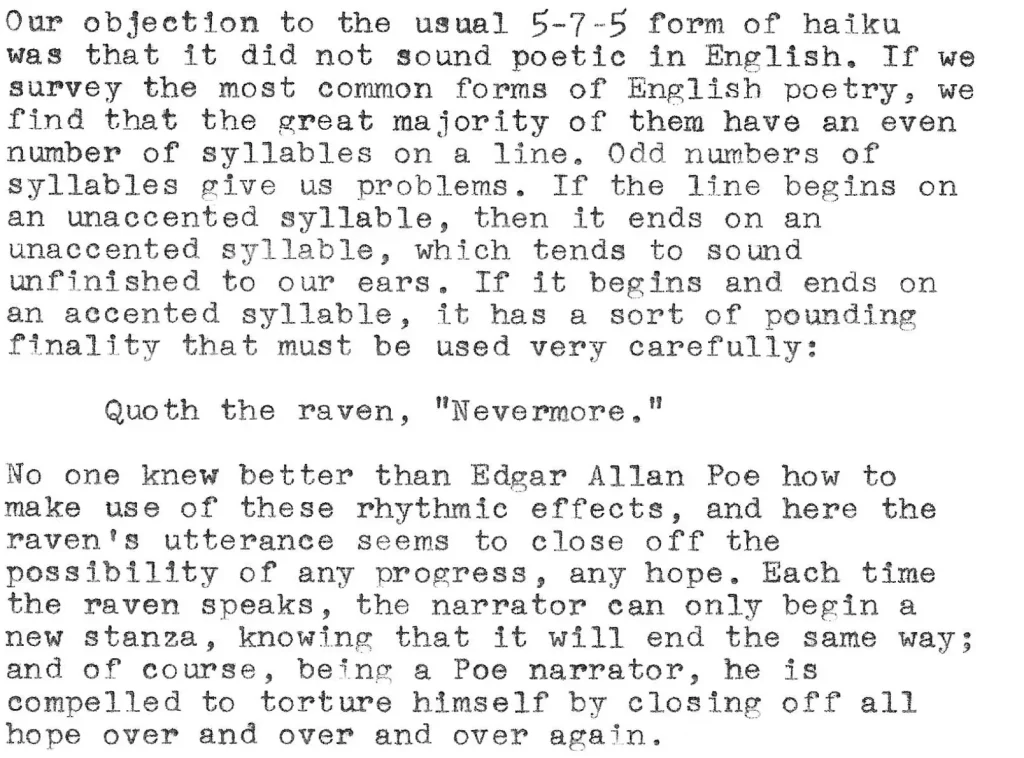



Update: Here is the future article in which we discuss the mystery of Gilbert’s limerick in blank verse.
Transcribed below. The typewriter is a Royal HH, the ugliest typewriter in the world.
If we are going to make our own form for haiku, then we ought to take into account what an older generation might have called the native genius of the English tongue. Our language moves to an iambic beat. It is certainly possible to write English poetry in other meters, but they tend to stand out as experiments. Dactyls, for example, make us think of silliness as soon as we hear them. The rhythm of the limerick in particular is so distinctive that you can hear it immediately without the aid of rhyme, as W. S. Gilbert demonstrated with a “Nonsense-Rhyme in Blank Verse”:
There was an old man of St. Bees
Who was stung in the arm by a wasp.
When they asked, “Does it hurt?”
He replied, “No, it doesn’t,
But I thought all the while ’twas a hornet.”
(There is, incidentally, a small mystery about this limerick, and we’ll come back to it in a future article.)
If the purpose of haiku is to convey the impression that a small observation made on the poet’s refined soul, then we want a meter that sounds poetic without drawing undue attention to itself. The form of the limerick draws attention to itself. When English poets want to write lines that sound poetic and natural at the same time, they nearly always give us iambs.
Our objection to the usual 5-7-5 form of haiku was that it did not sound poetic in English. If we survey the most common forms of English poetry, we find that the great majority of them have an even number of syllables on a line. Odd numbers of syllables give us problems. If the line begins on an unaccented syllable, then it ends on an unaccented syllable, which tends to sound unfinished to our ears. If it begins and ends on an accented syllable, it has a sort of pounding finality that must be used very carefully:
Quoth the raven, “Nevermore.”
No one knew better than Edgar Allan Poe how to make use of these rhythmic effects, and here the raven’s utterance seems to close off the possibility of any progress, any hope. Each time the raven speaks, the narrator can only begin a new stanza, knowing that it will end the same way; and of course, being a Poe narrator, he is compelled to torture himself by closing off all hope over and over and over again.
Right now we are not aiming for stunning rhythmic effects in our haiku, so we can start with the more versatile kind of line where an even number of syllables divides easily into a parade of iambs. That still gives us a wide range of possibilities. Milton’s blank verse, Chapman’s fourteeners, and Common Meter all fit that pattern.
So if the problem with the orthodox haiku form is that the lines have an odd number of syllables, then the easy and obvious way to address it is to add a syllable to each line. You will probably discover that this immediately absolves you from counting syllables: if you have any sense of rhythm, the lines will fall into place naturally.
The sunset fades to grey,
but in the east one cloud maintains
a stubborn tint of rose.A flash of bright chartreuse
resolves into a pointing form:
construction zone ahead.
We are almost tempted to say that we have solved the haiku problem with the simplest possible alteration. We have a form that is short, that sounds like poetry, and that can be worked into the structure of setup and punch line that orthodox haiku-makers regard as typical of the genre. This seems to be adequate. But perhaps we can aim for something more than adequacy.